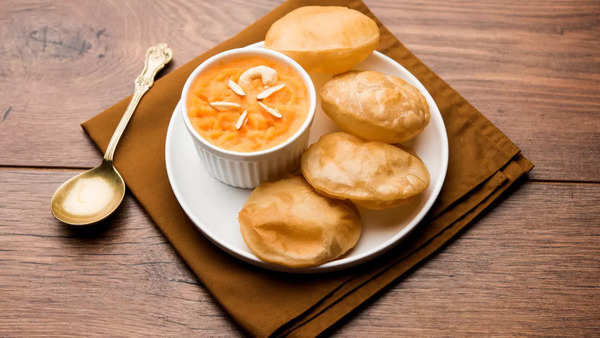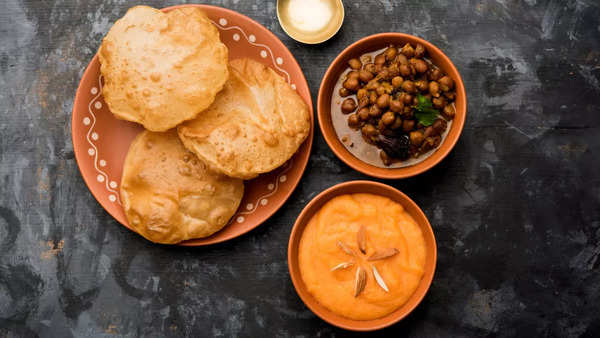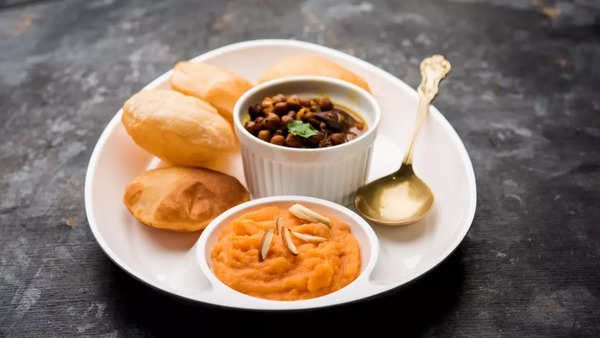Mythological belief
As per Devi Bhagwat Puran, it is believed that the young girls worshipped on this day are the forms of Goddess Durga. It is for the same reason that 9 girls along with 1 boy (called Langur) are worshipped and treated with good food, which is also known as Kanjak Puja or Kanya Pujan.

Significance of Chaitra Durga Ashtami
On this day, in some parts of the country, Chaitra Durga Ashtami holds commemorates the emergence of the goddess Chamunda from Mother Durga’s forehead. Chamunda then defeated the demons Chanda, Munda, and Rakthabija, who were allies of Mahishasura. During the Durga Puja rituals on Mahashtami, devotees venerate the 64 Yoginis and the Ashta Shakti or Matrikas, representing the eight fierce forms of Goddess Durga.
As per Mythology, these Ashta Shakti, also known as the Eight Shaktis, are revered across India and symbolize various manifestations of the divine feminine energy. The Eight Shaktis honoured during Durga Puja include Brahmani, Maheswari, Kaumari, Vaishnavi, Varahi, Narasinghi, Indrani, and Chamunda.
What experts say about the ritual of offering Poori, Halwa, and Kale Chane?
As per nutritionist Rujuta Diwekar, the combination of poori, halwa, and chana provides all essential nutrients to the human body that helps the digestive system to balance the mechanism after following sattvic diet for 7-8 days.
Benefits of Kanjak Prasad
Made in desi ghee chane, poori and halwa all three dishes are healthy. As per experts, chana and sooji are rich in dietary fibre and therefore contribute to better blood sugar levels. They also help maintain and balance cholesterol levels and thereby promote cardiovascular health. It has been found that black chana contains saponins, which prevent the cancer cell from multiplying and spreading in the body. It also contains selenium, important in detoxifying cancer causing compounds.

How to perform Kanjak
As per mythology experts, Kanjak Puja begins with washing the feet of young girls (aged between 2-10 years). Next, tilak is applied on their forehead and a kalava is tied in their hands. After that they are first given the prasad of tender coconut and are further offered Poorik Halwa, and Sookhe Kale Chane. In some parts of Northern India, many people also prepare Sattvik Aloo Gobhi or Aloo Tamatar along with Chane. At the end of puja, they are also given gifts in the form of money, jewellery, clothes, toys, etc. At last, the devotee touches their feet asking for their blessings and after their departure, the devotee breaks the fast with leftover bhog.
Date and timing of Ashtami and Navami
Ashtami Tithi begins at 12:11 on April 15, 2024
Ashtami Tithi ends at 13:23 on April 16, 2024
Navami Tithi begin at 1:23 pm on the April 16, 2024
Navmi Tithi ends at 3:15 pm on April 17, 2024

How to make Halwa, Poori, and Kale Chane
Ingredients for Halwa
1 cup semolina
1 cup ghee
1 cup sugar
2 cups water
2 tbsp roasted nuts
Method
Roast the semolina in a kadhai. Once the colour changes to golden, add ghee, and mix well. In the meantime, make a sugar syrup using water and sugar. Add it to the roasted semolina. Mix and cook until the desired consistency is achieved. Add nuts and mix well.
Ingredients for Poori
1 cup wheat flour
1 cup water
1 cup ghee
Method
Sieve flour in a mixing bowl. Use enough water to knead a soft dough. Roll out pooris and deep fry them in ghee.
Ingredients for Kale Chane
1 cup soaked kale chane
2 tomatoes
2 green chilli
4 tbsp ghee
2 tsp cumin seeds
salt to taste
1 tsp coriander powder
1 tbsp coriander leaves
Method
Pressure cook the soaked chane with water and some salt for 3-4 whistles. Heat ghee in a pan, add cumin seeds and green chillies. Sauté and then add chopped tomatoes. Cook for 3-5 minutes. Add the spices and salt. Mix well and then add boiled chane. Sauté and mix well. Cook for 5-6 minutes. Garnish with coriander leaves. Serve Poori, Halwa, and Chane to the Goddess.
Poori, Sooji Ka Halwa, & Sookhe Kale Chane Recipe
Thumb and Embed Images Courtesy: istock

